Lowcountry Inshore Fish Guide
Beaufort County waters boast some of the best salt water fishing along the East Coast. Redfish and Spotted Sea Trout are available year round, with some of the hottest action found during the fall months.
April and May welcomes the arrival of Cobia in the rivers and sounds. Fishing live bait throughout the water column produces powerful strikes.
In June we’ll begin to catch Spanish Mackerel and Bluefish at the rips and off the beaches. During the summer months there will be a large variety of sharks to test even the most seasoned angler. Other species active during the summer are Flounder, Whiting and Tarpon.
As fall approaches we’ll come upon some of the hottest action for Redfish and Trout on live bait under the popping cork. We catch and release Red Drum in the sound taken on live bait, which is an experience you’ll not soon forget.
Cobia
In the water, Cobia look very much like sharks. The usual color is brown or dark gray above, whitish on the underside, with a dark stripe running from gills to base of tail. The striped appearance is more vivid in juveniles. Several rather sharp finlets on the dorsal surface extend from behind the head to the dorsal fin.
Lowcountry Inshore Available Species:
Blue Fish

Blue fish color is steel blue or dark green above, shading to silvery white below. A dark spot usually shows at base of pectoral fin. Blue fish have large mouths with prominent teeth and a forked tail. Averages 1-3 pounds in most coastal waters of Florida, with catches to 6 or 7 pounds always possible, especially around major inlets, passes and jetties on both coasts.
Sheepshead
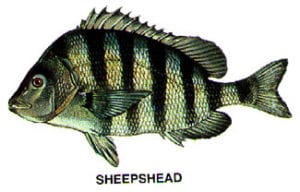
Black vertical bands stand out against dull white, gray or yellowish background. The mouth is full of massive, protruding teeth that give the fish its name, and distinguish it from the juvenile Black Drum , the only fish with which it is likely to be confused. Spines of the dorsal and anal fins are heavy and sharp.
Tarpon

Green or steel above, silver on sides and belly. Deep, thick body; forked tail. Long trailer at end of dorsal fin. From 12 inches or less to about 75 pounds, on average, although big fish of 100 to 150 pounds are numerous in many areas.
Black Sea Bass

Color is generally black or charcoal, with blue highlights and tiny white spots or stripes on dorsal fin. Indistinct pattern sometimes present on sides, especially in small fish. In adults, the dorsal, anal and caudal fins may have feathery edges, and large males show a distinctive hump forward of the dorsal.
Southern Kingfish
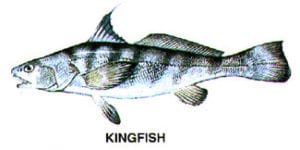
Also known as a Southern Whiting, the southern kingfish has a large head with one barbel at tip of lower jaw as well as a flattened belly. With an overall silvery color and tannish on top the kingfish also features indistinct dark blotches on side.
Red Drum
The Red Drum, also known as the Redfish or Channel Bass, has a reddish overall coloration and one or more dark spots at the base of the tail. It feeds at the bottom on crustaceans and mollusks. It also takes small fish, especially mullet. The usual adult weight is under 40 pounds but can reach into the 90 pound range.
Spotted Sea Trout
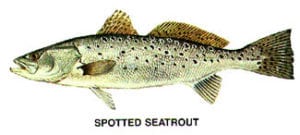
Streamlined shape; large mouth with prominent canine teeth; color gray or silvery with many prominent black spots on sides. Background may be quite dark, or gold, when fish are in back bays or streams.
Spanish Mackerel
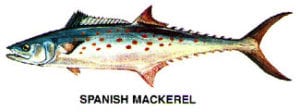
Dark above with silvery sides. Many spots, which are both yellow and brown. The body is proportionately deeper than with juvenile King Mackerel, and the yellow spots appear rounder and brighter, but if in doubt, the only true identifier is the lateral line, which tapers rather gently from front to back with no severe dip.
Southern Flounder
Brown or olive background, liberally marked with both dark blotches and white spots; however, the prominent eye-like spots (ocelli) of the Gulf Flounder are missing. It averages 2-4 pounds, but fish running 8-12 pounds are caught each year.
Ladyfish
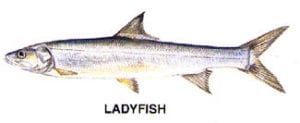
A slender, silvery fish with deeply forked tail and large, scoop-shaped lower jaw. Said to be mistaken at times for the Bonefish, but the error is difficult to conceive of, given the big mouth and jumping ability of the Ladyfish.
The Lowcountry’s remarkable saltwater ecosystem is unique and varied, providing exciting options for year round fishing adventures:
• Spring (March–May): Redfish, Trout, Flounder, Spanish Mackerel, Whiting, Black Drum, Sheepshead, Cobia, & Jacks.
• Summer (June–August): Redfish, Trout, Flounder, Spanish & King Mackerel, Jacks, Ladyfish, & Tarpon.
• Fall (September–November): Redfish, Trout, Flounder, Whiting, Sheepshead, Black Drum, Ladyfish, & Sharks.
• Winter (December–February): Redfish, Trout, Sheepshead, Black Drum & Whiting.


